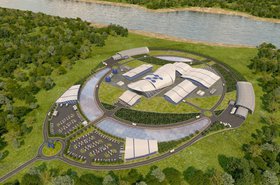When data centers rely on water for cooling, that water traditionally comes from a potable municipal water supply. But a laundry list of factors like water scarcity, community impact, and operating expenses have led many data center operators to consider alternative sources of water such as recycled wastewater, reused groundwater, or even rainwater collection.
Water supply not only plays a factor in meeting the five 9s uptime operating requirements of data centers, but it also can have a significant impact on capital and operational costs. This is why it’s critical to evaluate all available water sources during the early stages of site planning for new data centers or the expansion of existing facilities.
Here are some considerations to keep top of mind during the process.
Consider the relationship between growth and water
The number of hyperscale data centers has doubled over the past five years and the timeline for constructing new data centers has accelerated, putting added stress on the municipal water sources traditionally used for cooling purposes. Additionally, many of these new data centers being built have multi-phase expansion plans. The challenge is, each data center owner is only looking at the current and future needs of their own facilities. If there are multiple data centers in an area, the combined demand of those sites can stress the existing infrastructure of the municipality beyond its current design.
Building a new water or wastewater treatment plant or expanding the capacity of an existing facility would help solve this problem. However, bringing additional potable water capacity online can take time, leaving data centers with an insufficient amount of water supply or treatment capacity during the construction process.
One way data center operators can overcome this problem is by outsourcing the supply of their cooling system makeup water using solutions like mobile water treatment trailers, containerized systems, or fixed capital equipment. These mobile water treatment facilities can be used temporarily to meet a data center’s water and wastewater treatment needs for a few months or even years while the existing facilities are upgraded or a new facility is constructed, helping close or eliminate any expansion scheduling gaps.
While these solutions can fill the need for cooling system makeup water, effectively and accurately mapping out your long-term water needs during the planning stages of a new data center development or expansion helps prevent scheduling gap issues altogether and preserves flexibility for the future. Here’s how you can do that.
Evaluate water quality at the outset of any project
Characterization of source water should be one of the first steps in site planning, though it’s often overlooked during the early stages. Too often, owners may only analyze the most accessible water source, which doesn’t always work out in the long run.
Here’s a good example. An entity considering a parcel of land for data center development asked us to analyze groundwater before construction. The characterization revealed a very challenging composition of water that would only yield three cycles of concentration, even with heavy use of chemicals. Computer modeling showed a significant hike in operational costs and water use as a result. These early findings enabled them to identify an alternate site just a few miles away with significantly better water quality, resulting in much lower operational costs than the original site.
Weigh all the options
Owners should evaluate every possible water source to determine which one best meets the project’s requirements, such as reliability, reduced capital costs, efficient operation costs, etc.
For example, while many data centers source water from local municipal sources, potability isn’t a guarantee that the water quality is best suited for data center needs. Data center operators contending with municipal water that has hardness or other innocuous elements, can, and do, face significant inefficiency due to water treatment issues. Unfortunately, it’s not unheard of for an operator to discover that municipal water quality isn’t what they need until their efficiency degrades as the system load increases.
Enlist specialized expertise
Every water challenge can be solved, but some are more easily solved than others. Since water can impact data centers’ efficiency, both in terms of power usage effectiveness (PUE) and water usage effectiveness (WUE), enlisting experienced individuals with the right expertise is critical. Oftentimes, data centers have trouble finding individuals with the specialized expertise and experience needed to manage their water operations, especially if more complicated water sources are involved. Consider partnering with a third-party provider who knows the water landscape, can identify and solve water challenges early on, and has the foresight and expertise to ensure you have access to quality water sources throughout your data center’s lifecycle.
Bottom line: Data centers must think long-term and take any potential expansions into consideration when planning for water sources. Ask yourself, “will my original water source be able to continue supporting our data center’s needs if we double in size and computing after five years? What are the other available water sources I could use as a backup and how will they impact my overall operating efficiency and expenses of the site?” If you don’t think ahead and consider all factors, you could be left high and dry.





